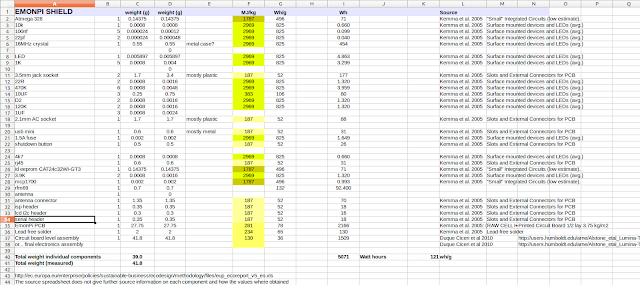Investigating the embodied energy of the EmonPi & OSCEDays London 12-14th June.
My impression of trying to look into embodied energy and life cycle analysis is that it seems that the measurement of embodied energy and other impacts associated with manufacturing our stuff and then the understanding of what solutions are available to reduce this embodied energy, especially in electronics is still in its infancy compared with other energy demands that we are more familiar with like the solutions available for space heating and transport, both of which have solutions that can achieve 70-90% energy reductions without reducing the level of comfort or distance travelled http://openenergymonitor.org/emon/sustainable-energy.
We're particular conscious of this question at OpenEnergyMonitor as we get our hardware manufactured and see the quantity of stuff involved in the production of our equipment. It has always been interesting to read about developments from other projects and companies who have been looking at this for sometime but in different fields predominantly outdoor clothing: http://www.patagonia.com/us/footprint and http://www.howies.co.uk. They have often achieved quite substantial improvements by looking at their materials, and supply chains in detail.
With Open Source Circular Economy Days coming up and after talking to Erica Purvis of http://technicalnature.org.uk/ who is one of the organisers of the London even we decided to try and sketch out a draft initial analysis of the embodied energy associated with the emonpi to take along with us. I emphasised its initial status there because I don’t have a high confidence in the reliability of the data at the moment but I think it does provide a useful start on which further detailed research can be done.
Embodied Energy Audit Process
With a little research I found an example of an embodied energy analysis for an LED light with an accompanying dataset for the embodied energy of different components here: http://users.humboldt.edu/arne/Alstone_etal_Lumina-TR9-Embodied-Energy_Jan11.pdf this example referenced data from the European commission project Eco-design of energy-using products: http://ec.europa.eu/enterprise/policies/sustainable-business/ecodesign/methodology/files/eup_ecoreport_v5_en.xls.
I then calculated an estimate for embodied energy by using the embodied energy dataset from these two sources and a detailed list of components for the emonpi including the weight of each component. The spreadsheet with the calculation can be downloaded here on the EmonPI open hardware github repository:
https://github.com/openenergymonitor/Hardware/raw/master/emonPi/emonPi_V1_5/emonpi_embodiedenergy.ods
here's a screenshot of what it looks like:
I have summarised the main results in these two graphics:
Interestingly the application of the embodied energy values in the dataset suggest that at least for the parts that we are most involved in the custom design of (The EmonPi Shield and the aluminium enclosure) the embodied energy is dominated first by the enclosure at 10.1 kWh and then by the manufacturing of the printed circuit board (2.2 kWh) and the assembly of the unit (1.6 kWh). The integrated circuits only account for a relatively small percentage at 0.2 kWh.
Aluminium enclosures
The estimate for the embodied energy of the aluminium enclosure is based on the 40 kWh/kg figure in Sustainable Energy without the hot air. This equates to 144 MJ/kg which is lower than a couple of other figures I could find for standard aluminium embodied energy. The Wikipedia figure is 155MJ/kg and is based on a 33% recycling rate. The figures I could find for the embodied energy for aluminium from bauxite where between 191MJ/kg and 342MJ/kg. The enclosure made from aluminium from bauxite could at the higher end use 24 kWh and at the lower end require 16 kWh. 100% Recycled aluminium however only requires between 11.35MJ/kg and 17MJ/kg. The EmonPi manufactured from 100% recycled aluminium would therefore only need between 0.9 - 1.3 kWh to manufacture. The EmonTH ABS plastic case is about a third of the size of the EmonPI case and weighs 32g it had an embodied energy of around 1.0 kWh (111MJ/kg). A plastic EmonPi case might weight about 3x this (~90 grams) and so may use around 3.0 kWh. The aluminium would need have been recycled around 7-8 times to achieve the same level of embodied energy as an ABS plastic enclosure. There are also lower embodied energy plastics available such as Polypropylene (64-94MJ/kg) and recycled PET may use around 42-55MJ/kg and then perhaps there are even more options in the design of enclosures to minimise the amount of material used.
Manufacture of printed circuit boards and assembly
Beyond learning more about enclosure options it would be useful to focus on getting a better idea for the reliability of the data for printed circuit board manufacturing and assembly and what options exist to lower their embodied energy requirements.
OSCEDays
If your interested in learning more about the Open Source Circular Economy days event or joining us at the event in London have a look at the event pages here:
https://oscedays.org
https://oscedays.org/london
Useful links and references:
- http://users.humboldt.edu/arne/Alstone_etal_Lumina-TR9-Embodied-Energy_Jan11.pdf
- http://ec.europa.eu/enterprise/policies/sustainable-business/ecodesign/methodology/files/eup_ecoreport_v5_en.xls.
- http://energy-solution.com/wp-content/uploads/2015/01/What-We-Know-and-Don---t-Know-about-Embodied-Energy-and-Greenhouse_Energy-Solutions_ACEEE-2012.pdf
- http://www.inference.phy.cam.ac.uk/withouthotair/c15/page_88.shtml
- http://www.appropedia.org/Life_cycle_analysis_of_polymer_recycling_literature_review
- http://openenergymonitor.blogspot.co.uk/2013/08/ethical-and-sustainable-electronics.html
- http://openenergymonitor.blogspot.co.uk/2013/09/faire-maus.html
- http://openenergymonitor.blogspot.co.uk/2012/05/embodied-energy-of-electronic-enclosure.html

